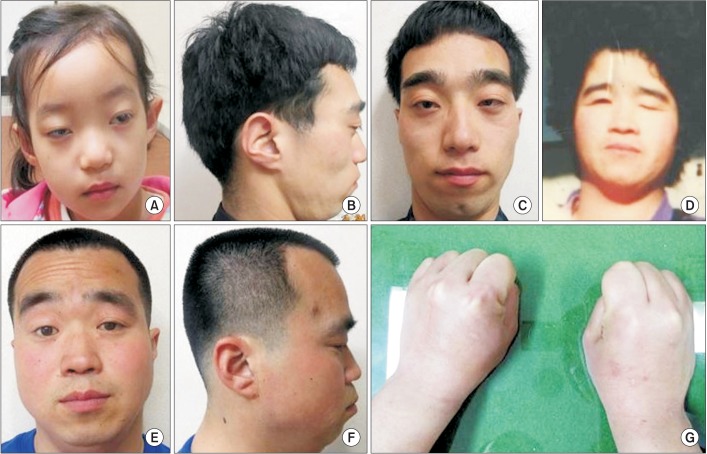Ann Rehabil Med.
2017 Jun;41(3):505-510. 10.5535/arm.2017.41.3.505.
Identifying the KAT6B Mutation via Diagnostic Exome Sequencing to Diagnose Say-Barber-Biesecker-Young-Simpson Syndrome in Three Generations of a Family
- Affiliations
-
- 1Department of Rehabilitation Medicine, Konyang University College of Medicine, Daejeon, Korea. jbocean@hanmail.net
- 2Department of Medical Genetics, Konyang University College of Medicine, Daejeon, Korea.
- KMID: 2389469
- DOI: http://doi.org/10.5535/arm.2017.41.3.505
Abstract
- Diagnostic exome sequencing (DES) is a powerful tool to analyze the pathogenic variants leading to development delay (DD) and intellectual disability (ID). Recently, heterozygous de novo mutation of the histone acetyltransferase encoding gene KAT6B has been recognized as causing a syndrome with congenital anomalies and intellectual disability, namely Say-Barber-Biesecker-Young-Simpson (SBBYS) syndrome. Here we report a case of SBBYS syndrome in a third generation Korean family affected with a missense mutation in KAT6B, c.2292C>T p.(His767Tyr) identified by DES. This is the first confirmed familial inherited mutation of the KAT6B reported worldwide. Our case emphasizes again the importance of basic physical examination and taking a family history. Furthermore, advances in genetic diagnostic tools are becoming key to identifying the etiology of DD and ID. This allows a physiatrist to predict the disease's clinical evolution with relative certainty, and offer an appropriate rehabilitation plan for patients.
Keyword
MeSH Terms
Figure
Reference
-
1. Moeschler JB, Shevell M. American Academy of Pediatrics Committee on Genetics. Clinical genetic evaluation of the child with mental retardation or developmental delays. Pediatrics. 2006; 117:2304–2316. PMID: 16740881.
Article2. Clayton-Smith J, O'Sullivan J, Daly S, Bhaskar S, Day R, Anderson B, et al. Whole-exome-sequencing identifies mutations in histone acetyltransferase gene KAT6B in individuals with the Say-Barber-Biesecker variant of Ohdo syndrome. Am J Hum Genet. 2011; 89:675–681. PMID: 22077973.
Article3. Campeau PM, Lu JT, Dawson BC, Fokkema IF, Robertson SP, Gibbs RA, et al. The KAT6B-related disorders genitopatellar syndrome and Ohdo/SBBYS syndrome have distinct clinical features reflecting distinct molecular mechanisms. Hum Mutat. 2012; 33:1520–1525. PMID: 22715153.4. Kraft M, Cirstea IC, Voss AK, Thomas T, Goehring I, Sheikh BN, et al. Disruption of the histone acetyltransferase MYST4 leads to a Noonan syndrome-like phenotype and hyperactivated MAPK signaling in humans and mice. J Clin Invest. 2011; 121:3479–3491. PMID: 21804188.
Article5. Simpson MA, Deshpande C, Dafou D, Vissers LE, Woollard WJ, Holder SE, et al. De novo mutations of the gene encoding the histone acetyltransferase KAT6B cause Genitopatellar syndrome. Am J Hum Genet. 2012; 90:290–294. PMID: 22265017.
Article6. Vlckova M, Simandlova M, Zimmermann P, Stranecky V, Hartmannova H, Hodanova K, et al. A patient showing features of both SBBYSS and GPS supports the concept of a KAT6B-related disease spectrum, with mutations in mid-exon 18 possibly leading to combined phenotypes. Eur J Med Genet. 2015; 58:550–555. PMID: 26370006.
Article7. Gannon T, Perveen R, Schlecht H, Ramsden S, Anderson B, Kerr B, et al. Further delineation of the KAT6B molecular and phenotypic spectrum. Eur J Hum Genet. 2015; 23:1165–1170. PMID: 25424711.
Article8. Yilmaz R, Beleza-Meireles A, Price S, Oliveira R, Kubisch C, Clayton-Smith J, et al. A recurrent synonymous KAT6B mutation causes Say-Barber-Biesecker/Young-Simpson syndrome by inducing aberrant splicing. Am J Med Genet A. 2015; 167A:3006–3010. PMID: 26334766.
- Full Text Links
- Actions
-
Cited
- CITED
-
- Close
- Share
- Similar articles
-
- A neonate with Say–Barber–Biesecker–Young– Simpson syndrome with a novel pathogenic mutation in KAT6B gene: A case report
- Genitopatellar Syndrome Secondary to De Novo KAT6B Mutation: The First Genetically Confirmed Case in South Korea
- Exome Sequencing in Mendelian Disorders
- Identification of Two Cases of Ciliopathy-Associated Diabetes and Their Mutation Analysis Using Whole Exome Sequencing
- Whole Exome Sequencing of a Patient with Duchenne Muscular Dystrophy




